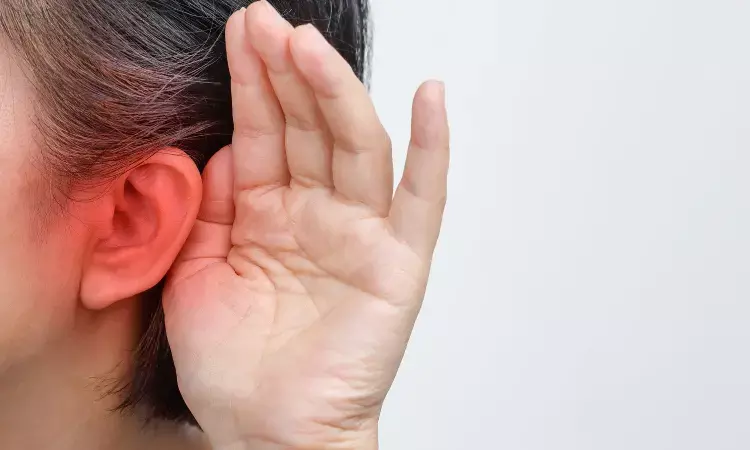- Home
- Medical news & Guidelines
- Anesthesiology
- Cardiology and CTVS
- Critical Care
- Dentistry
- Dermatology
- Diabetes and Endocrinology
- ENT
- Gastroenterology
- Medicine
- Nephrology
- Neurology
- Obstretics-Gynaecology
- Oncology
- Ophthalmology
- Orthopaedics
- Pediatrics-Neonatology
- Psychiatry
- Pulmonology
- Radiology
- Surgery
- Urology
- Laboratory Medicine
- Diet
- Nursing
- Paramedical
- Physiotherapy
- Health news
- Fact Check
- Bone Health Fact Check
- Brain Health Fact Check
- Cancer Related Fact Check
- Child Care Fact Check
- Dental and oral health fact check
- Diabetes and metabolic health fact check
- Diet and Nutrition Fact Check
- Eye and ENT Care Fact Check
- Fitness fact check
- Gut health fact check
- Heart health fact check
- Kidney health fact check
- Medical education fact check
- Men's health fact check
- Respiratory fact check
- Skin and hair care fact check
- Vaccine and Immunization fact check
- Women's health fact check
- AYUSH
- State News
- Andaman and Nicobar Islands
- Andhra Pradesh
- Arunachal Pradesh
- Assam
- Bihar
- Chandigarh
- Chattisgarh
- Dadra and Nagar Haveli
- Daman and Diu
- Delhi
- Goa
- Gujarat
- Haryana
- Himachal Pradesh
- Jammu & Kashmir
- Jharkhand
- Karnataka
- Kerala
- Ladakh
- Lakshadweep
- Madhya Pradesh
- Maharashtra
- Manipur
- Meghalaya
- Mizoram
- Nagaland
- Odisha
- Puducherry
- Punjab
- Rajasthan
- Sikkim
- Tamil Nadu
- Telangana
- Tripura
- Uttar Pradesh
- Uttrakhand
- West Bengal
- Medical Education
- Industry
Dysfunctional gene leads to potentially treatable hearing loss

Researchers at the John T. Macdonald Department of Human Genetics and John P. Hussman Institute for Human Genomics at the University of Miami Miller School of Medicine have found that inherited mutations in the MINAR2 gene caused deafness in four families. The gene variation mostly affects the inner ear hair cells, which are critical to hearing. The authors believe the progressive nature of this hearing loss, in some affected individuals and in mice, could offer opportunities for treatment. The study was published on June 21 in the journal PNAS.
"MINAR2 plays a major role in hearing, and these inherited mutations lead to sensorineural deafness," said Mustafa Tekin, M.D., a professor in the Dr. John T. Macdonald Foundation Department of Human Genetics and senior author on the paper. "The findings suggest these cases may be suitable for intervention with genetic therapies."
Dr. Tekin has been studying the genetic underpinnings behind hearing loss for more than 20 years and has amassed a biorepository with genomic sequencing database of deafness-associated gene mutations in families all over the world.
"We first look at known genes mutations," said Dr. Tekin. "If we don't find any, we conduct whole genome sequencing to potentially identify new genes or something we may have missed in the initial test."
In this study, the team sequenced a Turkish family's genome, targeting known deafness genes, but found nothing. Following up with whole genome sequencing, they found DNA variants in MINAR2, which had only recently been described in the research literature. Scientists are still filling in the blanks on the gene's function.
Having identified the variations in MINAR2 in one family, Dr. Tekin's team searched their database and found a second family with a different mutation in the same gene. Further investigation confirmed their findings in animal studies and identified three different MINAR2 mutations, which caused deafness in 13 people from four families.
"We found this gene serves an important function," said Dr. Tekin. "The protein localizes in hair cells and other areas that are critical to hearing. Future research will focus on clarifying the gene's role."
Hair cells convert sound into electrical signals, which are then sent to the brain. Normally, when children are born deaf, they have few if any living hair cells. As a result, gene therapies and other regenerative efforts would likely fail. However, in the mouse knockout model of MINAR2, hair cells remain alive until a later age. This gradual loss of hearing could allow for treatment.
"What is surprising and promising for potential intervention is that, when we looked at the hair cells in our mouse model, they are alive until a certain age," said Tekin. "That gives us a window of opportunity to provide treatment. We could insert the normal gene and potentially restore hearing."
Reference:
Mutations in MINAR2 encoding membrane integral NOTCH2-associated receptor 2 cause deafness in humans and mice Guney Bademci, María Lachgar-Ruiz, Mangesh Deokar, and Mustafa Tekin, Edited by Mary-Claire King, University of Washington, Seattle, WA; received March 8, 2022; accepted May 11, 2022 June 21, 2022 119 (26) e2204084119 https://doi.org/10.1073/pnas.2204084119
Dr Kamal Kant Kohli-MBBS, DTCD- a chest specialist with more than 30 years of practice and a flair for writing clinical articles, Dr Kamal Kant Kohli joined Medical Dialogues as a Chief Editor of Medical News. Besides writing articles, as an editor, he proofreads and verifies all the medical content published on Medical Dialogues including those coming from journals, studies,medical conferences,guidelines etc. Email: drkohli@medicaldialogues.in. Contact no. 011-43720751


